How many anime are there? 2/3
Understanding of the Japanese animation industry has come a long way in English-speaking circles. However, although in-depth archives or detailed anecdotes about specific productions have become easier to find, a general overview of the industry as a whole is still lacking. This series is not intended to provide anything quite as ambitious, but hopes to provide some of the resources needed to move in that direction.
The aim of this series is therefore to offer a quantitative perspective on the Japanese animation industry, sharing some of the figures and data available in Japanese, but not in English. Numbers are not absolute, and they are not the key to a final, "objective" approach to the animation industry. But they can help us obtain a distance and perspective that the usual, qualitative approach does not, or rarely, have. Each entry in this series will therefore use different sources, on various topics related to the animation industry, in the hopes of clarifying and improving our overall knowledge on this subject.
The first entry in this series, looking at the total number of anime in production, is available here .
Last time I concluded by stating that the mere number of anime in production, or even the number of minutes of animation produced, is not enough to provide a true perspective on the state of the anime industry. Japanese animation. Alongside other factors such as general profit and growth, this can give us an idea of the overall development of the industry and how business is doing overall, but it doesn't add much about how things actually work on the production side.
To begin discussing this issue, I will therefore provide some data on animation studios; next time will be about animation production staff. The figures come from two sources: an August 2022 survey conducted by the company Teikoku Data Bank, supplemented by a 2019 survey conducted by the Japanese Animation Creators Association (JANICA).
First, let's start with a basic question: how many animation studios are there? According to the Teikoku survey, there are 309 studios in total , from large production companies to small studios specializing in subcontracting. Unsurprisingly, the majority (276) are located in Tokyo. The sample is much smaller, but the JANICA survey also shows centrism in Tokyo, as 76.2% of respondents said they live in Tokyo, and 12.3% in Kanto, around the capital.
As the chart below shows, most animation studios are very small, whether in terms of profits or number of employees. These numbers are not surprising, because this structure has been characteristic of the animation industry since the very beginning. What's perhaps more surprising, however, is how new most of the studios are - 200 were created after the year 2000. Although it's hard to tell without more data spread across the time, this could indicate two possible, non-contradictory phenomena:
1) The anime industry is vibrant, attracting more people to join and start businesses
2) The anime industry is unstable and the lifespan of an animation studio is very short, causing most of the old companies to disappear
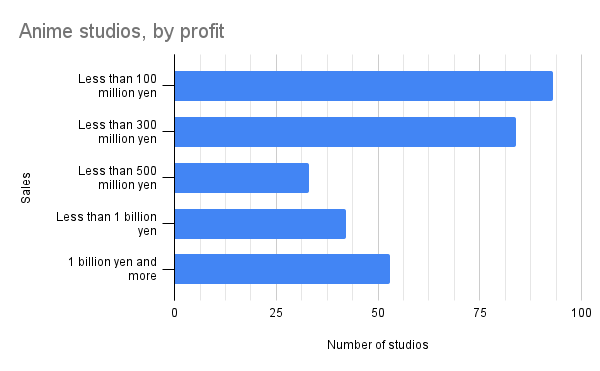
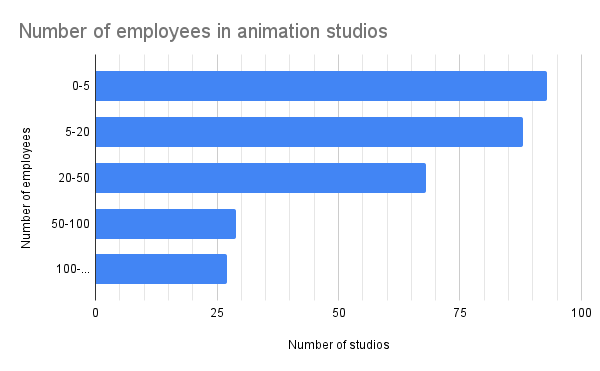
With these general numbers in mind, we can turn to more interesting data: the business performance of animation studios. With these figures, it is possible to get a better overview of the general state of the industry and whether those who support it are indeed doing so sustainably. And the answer here is clear: the animation industry is not sustainable . Of course, she never was - but that doesn't make the situation any less worrying. Between 2019 and 2021, overall profits in the animation market declined, a downward trend generally attributed to the pandemic. However, given the fragility of most studios, the results are more visible on an individual level than for the industry as a whole.
As the chart below shows, in terms of sales the situation is already not good - just over a third of studios have seen their sales decline. But the real problem lies in real profits: almost 40% of all studios are in the red (a record), while 23% have seen their profits decline.
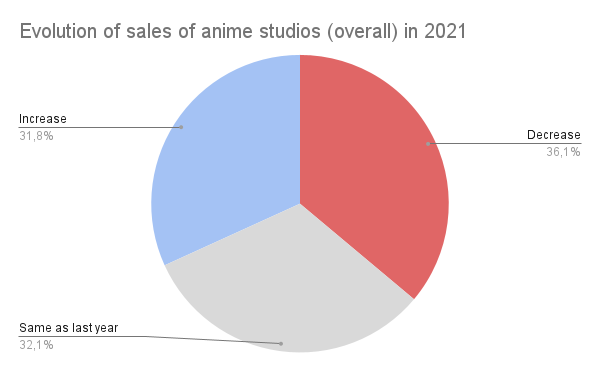
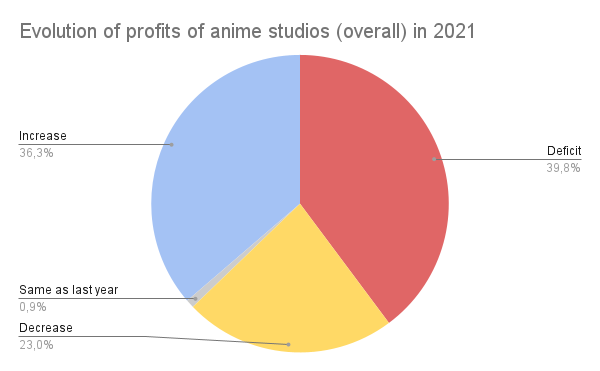
The numbers become even more worrying when we separate the different types of studios as below: On the left are main contractors and subcontractors, i.e. studios capable of handling all or most of the process , and on the right the "specialized" studios, which only take care of one task of the process, such as intermediation, coloring or photography. While still not reassuring, the numbers are relatively balanced between main contractors and subcontractors, while an overwhelming majority of specialist studios find themselves in a precarious situation. As previously mentioned, animation studios have always been in dire financial situations, but the numbers presented here appear to be some of the worst on record. Notably, this is the second year in a row that more than 40% of specialized studios are in deficit, the first time this has happened.
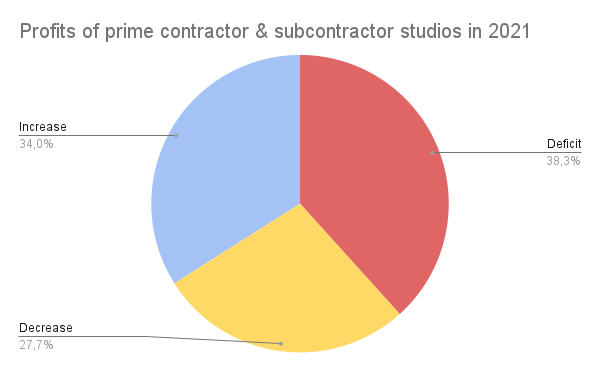
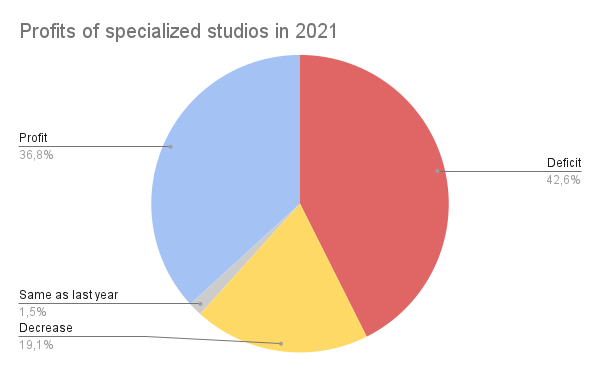
In the short term, the pandemic once again appears to be the cause. Fewer productions mean less revenue (although it can mean less work and better conditions for individuals), while specialist studios constantly face the costs of upgrading their equipment.
Decreasing the number of overall productions creates a vicious cycle for studios: fewer productions means less revenue, which diminishes each studio's ability to update its tools, increase its staff, and ultimately increase its revenue. As is often discussed, some studios try to break out of this vicious cycle through brute force, taking on more orders than they can actually handle. But this doesn't really improve things for several reasons:
- This makes working conditions more difficult for core staff, decreasing their overall efficiency and increasing competition between studios.
- Ultimately this doesn't solve the problem, as new employees have to be brought in to solve the work overload problem, meaning the studio will have more people to pay and make less money, starting the cycle again
- This ultimately relies on the premise that there are more staff to recruit in the first place
For these reasons, while decreasing the number of productions is a source of problems, increasing this number is not really a good solution either. So the main problem is twofold: studio management and how to ensure that studios can actually make a profit in a sustainable way.
A more lasting trend, which has only been accelerated by the pandemic, appears to be the widening gap between "major" and "minor" studios. Large studios are those that have a large workforce, stable subcontracting networks, and notably hold certain rights to their intellectual properties. Thanks to this, they are able to maintain production and profit from their works even when they are released on streaming services. A spectacular case of this has been the conglomerate IG Port, and more specifically the studio WIT, which appears to have benefited enormously from the success of Ousama Ranking and, most notably, Spy X Family .
Here it is time to enter more speculative territory, as this trend may be set to suddenly accelerate due to another factor: the reform of the Japanese consumption tax, also known as the law " invoice", which is expected to come into force in October 2023. In summary, the system by which companies will fill out invoices to be exempt from consumption tax will become more complex and will establish a clear separation between the profits of companies and those of freelancers working with them. This will make administrative management more difficult, but that's not all. As a result, freelancers earning below a certain level will have to pay more taxes (up to 10% of their income), or studios will have to bear these costs, making it very disadvantageous for them to employ freelancers. freelancers. As we'll see in the next part, the vast majority of animation workers in Japan are freelancers - not just animators, but also actors and many other positions throughout the production chain. This could mean that, within a few years, many freelancers may quit and smaller studios unable to bear the costs will close, while larger ones, making more profits and having more in-house staff, will be less affected.
In the next part, we will focus on the animation staff themselves and their "working conditions". We'll cover topics like salaries, working hours, and how they change over time.








